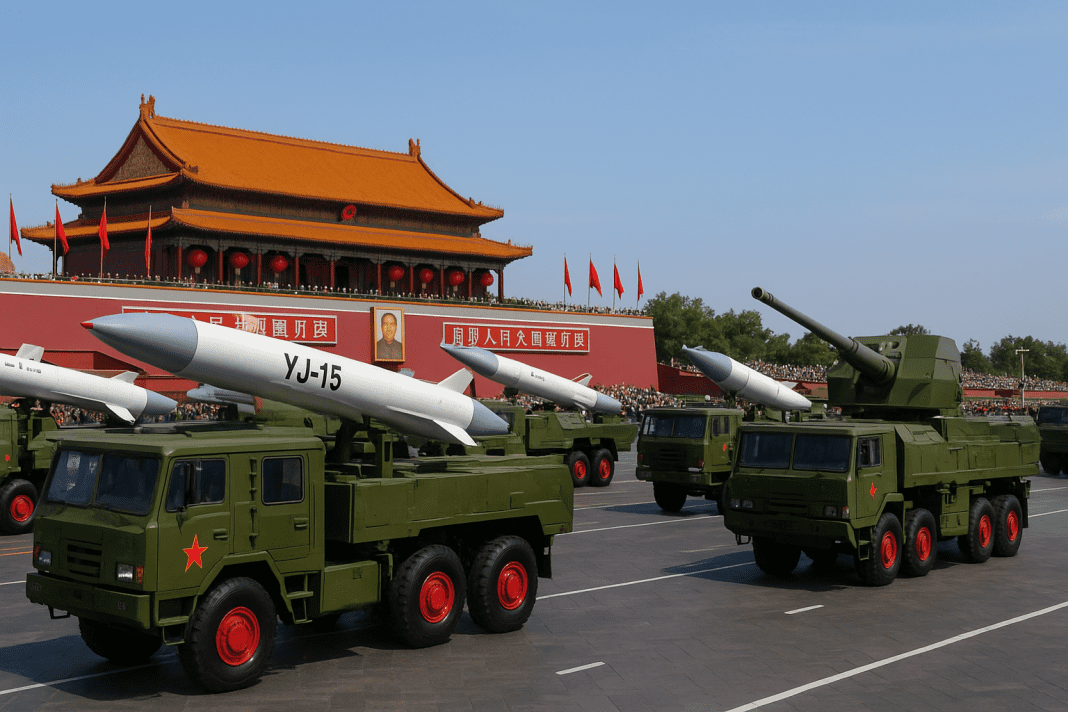China’s naval weapons were the highlight of the military parade in Beijing’s Tiananmen Square on 3 September. The parade showed a powerful collection of new naval weapons, including several advanced anti-ship missiles that make China’s navy more capable and dangerous.
Impressive Naval Weapons: Anti-Ship Missiles Lead the Parade
One of the most notable naval weapons is the YJ-15 anti-ship missile. The YJ-15 measures about 6.7 meters in length, and J-15 fighter jets launch it from Chinese aircraft carriers. The missile flies close to the sea surface at high speed, which makes it harder for enemy ships to detect. Its range may reach around 200 kilometers.
Three other naval weapons in the form of missiles travel even faster. These hypersonic missiles can reach speeds higher than Mach 5, more than five times the speed of sound.
Chinese destroyers such as the Type 052D and Type 055 launch the YJ-17, a boost-glide missile that skips off air shockwaves and can quickly change direction.
Chinese drone subs set to make first public appearance in Beijing parade
The YJ-19 is another hypersonic naval weapon. It strikes ships or land targets rapidly and may use a scramjet engine for propulsion. Submarines could possibly launch it from torpedo tubes, which would allow China’s submarines to carry these powerful naval weapons.
The YJ-20 completes the anti-ship missile group. This multistage missile combines the speed of a ballistic missile with high maneuverability at its final stage. Chinese forces previously tested it, but they only recently revealed its name. Larger warships launch the YJ-20, and it can reportedly hit aircraft carriers from near-vertical angles.
These anti-ship naval weapons include different designs and methods of attack, making it difficult for enemy ships to defend themselves. The missiles are fast, can change direction, and may be launched from ships, aircraft carriers, or submarines.
Advanced Weapons: Air Defense and Attack Systems Also Showcased
Along with anti-ship missiles, China displayed other advanced naval weapons that defend ships from aerial threats and support land attacks.
The YJ-18C is a land attack naval weapon with a sharp shape that may reduce its radar visibility. The missile likely travels at subsonic speed but accelerates briefly to high speed before hitting its target. It carries a powerful 500 kg warhead and performs precise strikes.
China presented several naval weapons for air defense:
- The HQ-16C is a medium-range missile system that likely arms frigates such as the Type 054A and 054B. It can intercept both slow and fast anti-ship missiles as well as aircraft at distances of 100–120 km and altitudes up to 40 km.
- The HHQ-9C is a long-range air defense missile. It has a larger booster and advanced thrusters that help it hit targets at high altitudes. It is designed to intercept incoming ballistic missiles and can be packed efficiently inside launch tubes.
- The HQ-10 is a short-range naval weapon similar to systems used by other countries. It defends ships from nearby threats.
China to impose tariffs of up to 78.2% on U.S. optical fibre imports
One of the most futuristic naval weapons on display was the LY-1 laser weapon. This new type of defense tool is mounted on a Chinese landing platform ship. It can instantly target incoming missiles or drones and disrupt their sensors, helping to protect ships from surprise attacks.
These air defense naval weapons form a network that shields China’s naval forces from a variety of threats.
Naval Weapons Below the Surface: Torpedoes and Unmanned Systems
China’s naval weapons were not only on the surface but also below the water. The parade featured new torpedoes and unmanned vessels that increase its ability to fight both above and below the sea.
China showcased an unmanned surface vessel (USV) equipped with a mine-laying system and a medium-caliber cannon for self-defense. Twin waterjets power this naval weapon, and it likely operates close to the shore. It is expected to replace older mine-clearing drones and support mine removal missions.
For underwater combat, China displayed three new naval weapons in the form of torpedoes:
- Aircraft or ships can launch the AMB012 lightweight torpedo, which resembles older models and is designed for shallow water operations.
- The AJC015 rocket-assisted torpedo launches from deck-mounted canisters, like those used for anti-ship missiles. It moves at high speed and can target submarines.
- Submarines deploy the AQA010 heavyweight torpedo, which has a 533 mm diameter. It supplements or replaces older models.
These new naval weapons enhance China’s underwater strike capabilities and improve mine-clearing operations, making its naval forces stronger across multiple environments.
This parade demonstrated how China’s weapons are expanding in strength and technology. From missiles to defense systems and underwater tools, these weapons show how China’s navy is preparing to protect itself and project power at sea. The inclusion of different types of naval weapons makes defending against them harder for other countries, highlighting China’s growing military capabilities.

